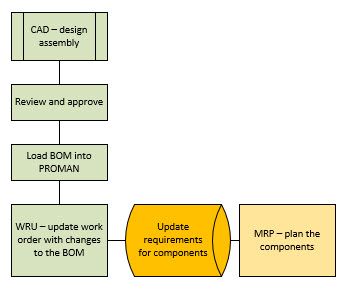In this environment, the finished part may have many iterations of this process. Designing certain assemblies, reviewing them, and then releasing them to plant to build. In our system, we can run our update process as many times as you like. Each time will load the requirements up to the system and then planning portion will start to acquire the parts.
The existing parts on the work order may be in the planning process, in the purchase process, or received. The update process then adds or adjusts the components to reflect the current bill, if it can. Any part already received, cannot be deleted from the work order, and is reported as discrepancy.
Our system also supports phantom parts (or Make-On-Assembly) parts. We call this a MOA flag. When creating a work order (or updating it), and the single level bill of material contains a MOA part (or many), the system will traverse the BOM for the MOA part and add those parts to the requirements of the work order. This means that you can have a group of assembly drawings (each with a MOA part) and each drawing can have its own group of components listed. This allows you to break large projects into smaller manageable pieces. The choice is yours in how you make the the bill of material.
Some environments create a master for a project. They then copy this to the current project (work order) that has a set of standard MOA parts on it. They then use this as the project definition and can monitor the progress of engineering by (and if) the MOA parts have their bill of material released yet.
We have clients that have more than a thousand parts in hundreds of assemblies, all on one project.
Give us a call to talk about how we can help with your ETO process.
1-888-PROMAN1

